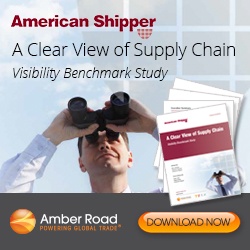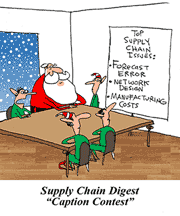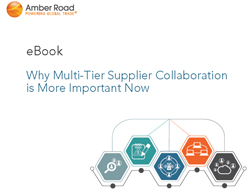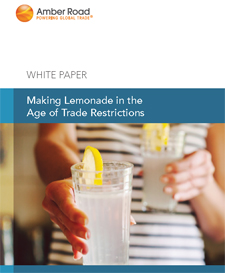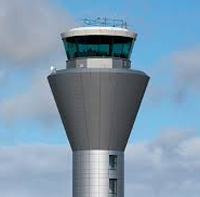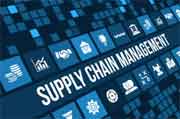Supply Chain Year in Review 2017
I am back as usual at the beginning of each new year with a look at the key trends and news in supply chain. There was a lot of action, no doubt about that.
We start with impact of the new of the Trump administration. The most notable supply chain effect of Trump has been on trade, with the US exiting the proposed Trans-Pacific Partnership (TPP) trade agreement with more than 10 other nations in January. Negotiations on amending NAFTA agreements are not going well.
The Trump administration also called for a review of whether China is systematically engaged in stealing US intellectual property in a variety of ways - with potential strong actions such as a big increase in duties on Chinese imports. Ditto with a recent finding that the US aluminum industry has been hurt by Chinese imports - all of this and more could have a major supply chain impact.
| GILMORE SAYS: |
Robots continue to advance at a mind-boggling pace and may soon take over the world. Blockchain announcements came fast and furious.
WHAT DO YOU SAY?
Send us your
Feedback here
|
In a highly controversial move in June, Trump also withdrew the US from the UN Climate Accord struck in Paris in 2015 - though many US companies have said their efforts to comply with the targets will continue on, amid recent rumors Trump may jump back into the agreement.
We did not get a "border tax" on imports, but did see a reduction in the maximum business tax to 21% - a move long called for by the US National Association of Manufacturers.
The economy started as usual in recent years with a weak Q1, but then jumped to 3.1% and 3.2% growth in Q2 and Q3, respectively. With most predictions also saying Q4 will be strong. There is an outside chance the US could see full year GDP growth of 3+% for the first time since 2005.
With the growth in the economy, transportation costs are rising. The Cass Linehaul index jumped a significant 6.3% year over year in November, and is up now for eight consecutive months, with accelerating increases. Watch out in 2018.
Global trade volumes climbed, and there was decent growth in container shipping after a very weak 2016. That sent ocean rates jumping.
The term "retail apocalypse" came into common usage, with more than 8000 stores shuttered in the face of ecommerce and changing shopping habits, though with new stores the next loss was more like 6000+.
To me this year was something of an inflection point for electronic cars and trucks, with a number of nations announcing plans to end the sale of gas-powered cars in 2 decades or so - and Tesla's electric Semi sort of unveiled.
Robots continue to advance at a mind-boggling pace and may soon take over the world. Blockchain announcements came fast and furious. China announced plan to dominate the world and continued to build and fortify fake islands.
With that overview of key themes, here are the top news stories by month in 2017. The full list is far longer than I have room for in this space, but can be found here:
January
Procter & Gamble announces it will make additional investments in recycling and beneficial reuse that will eliminate all manufacturing waste from its global network of more than 100 production sites by 2020.
Amazon raises eyebrows with announcement of plans for major $1.5 billion air shipping hub at the Cincinnati airport, with more than 200 flight departures and landings per day to be scheduled. Amazon denies it plans to enter parcel in a big way, saying facility is just to meet peak demand requirements. Sure.
February
In a surprising move, Kellogg says it will end its direct store delivery (DSD) model for the supply chain of its snacks business (crackers, etc.), moving to shipments to retailers' distribution centers instead. As a result, Kellogg said it would close 39 distribution centers, which will all shutter by the fourth quarter of 2017.
In probably the biggest labor action of the year, workers at Boeing's aircraft factory in South Carolina handily defeat a vote to join the International Association of Machinists and Aerospace Workers (IAM). 74% say no, continuing the unbroken trend of unions losing major votes in Southern states in recent years.
March
The American Society of Civic Engineers released in quadrennial study on the state of US infrastructure, and as usual it painted a dismal picture, giving the nation's overall infrastructure a grade of D+. Roads earned a D, bridges C+, ports C+, and perhaps surprisingly a B for rail.
Pizza giant Domino's says it is making real pizza deliveries over the roads in Hamburg, Germany using the six-wheeled robots that sort of looks like R2D2 from Star Wars with a storage compartment. The delivery robots are made by Starship Technologies, which has several tests going around the world.
April
The new Ocean Alliance and TheAlliance container shipping consortia begin operations, with shared operating assets among member carriers, joining the Maersk-led 2M agreement to leave three major alliances.
Walmart, saying it can't battle climate change on its own, announces Project Gigaton, which has goal of reducing a gigaton of CO2 emissions from its extended supply chain by 2030, in part by putting pressure on its suppliers.
May
Amazon holds a meeting of leading consumer packaged goods companies trying to convince them to sell direct via Amazon instead of relying on traditional retailers. "Times are changing," Amazon says in an invitation obtained by Bloomberg.
Gartner announces it top 25 supply chain for 2017, led by Unilever, followed by McDonald's, Inditex (Zara), Cisco, and H&M. Procter & Gamble and Apple not on list after again being placed in a sort of hall of fame.
June
The expanded Panama Canal celebrates its first year of operation and is already having a big impact on global logistics, with volumes and ship sizes up sharply.
Amazon announces its plans to acquire grocer Whole Foods and its 400+ well-placed stores. Speculation is rampant on what the strategy will be, but general consensus Amazon will take big costs out of the grocer's supply chain and use the stores as a platform for ecommerce pick-up and delivery services.
Ocean carrier Maersk Line, FedEx's European TNT units, and several manufacturing plants hit with cyber-attacks they take down their services for a day or more, as efforts seem focus on disrupting supply chains.
July
Amazon announces it plans to hire 50,000 additional new fulfillment center workers by end of the year, putting additional pressure on an already tight DC labor market in most areas.
City Bank study claims the US Post Office is giving Amazon a $1.46 subsidy on very package shipped, as USPS gets around law requiring it to not price below its costs.
Walmart announces program On-Time, tightening windows for delivery from vendors backed by chargebacks in effort to reduce supply chain variability.
August
MIT researchers say they have invented new technology for use of drones and RFID in distribution centers that dramatically increases the read range of passive tags, making use of the technologies much more practical to take physical inventories.
West Coast port workers sign three-year contract extension, providing labor stability now through 2020, as both sides look to slow erosion of container volumes to other ports through the Panama Canal.
September
Truck drivers in an event called Run on Less were able to average 10.1 miles per gallon over 50,000 miles travelled using only relatively modest technical advances and their own driving skills.
Report from the International Transport Forum in Europe says autonomous trucks could reduce truck driver jobs 50-70% in the U.S. and Europe by 2030, calls for nations to prepare for social disruption now, perhaps require slower phase-in of the technology.
October
Contract manufacturing giant Foxconn announces it has selected Southern Wisconsin for a massive new flat panel factory that may employ as many as 10,000 workers.
Amazon announces Seller Flex program, in which the company will pick up packages from merchants on its Amazon Marketplace service and get them into its network for customer delivery. Program is thought to be in part way to reduce need for additional fulfillment center space.
American Trucking Associations says US driver shortage will reach all time high by year's end, at 50,000, headed higher. JB Hunt sends letter to customers warning truckload rates could soon jump 10% or more, largely due to the US driver shortage.
November
With great fanfare, Tesla CEO Elon Musk unveils two coming electric truck models - the Tesla Semi. Promised for 2019 delivery - though critics says much of the battery technology does not yet exist. Many large companies do ordered test units, led by Pepsico's order for 100 units.
Negotiations for a redo of the NAFTA trade agreement between the US, Canada and Mexico hit more bumps, with next talks set for January, as US trade representative is pessimistic on chances of success.
December
New CSX CEO Hunter Harrison dies, leaving the legendary executive's plans for implementing his vision of "precision railroading" operations uncertain at the carrier, though CSX says that that train has already left the station, if you will.
The mandate from use of electronic data loggers (ELDs) on all trucks from the FMCSA take effect on the 18th, though will be somewhat phased in. Impact on capacity and thus rates uncertain from prohibiting drivers from cheating on hours of service rules.
That's it. Year in numbers and charts next week.
Any reaction to Gilmore's review of 2017 in supply chains? What would you add to the key trends and themes? Let us know your thoughts at the Feedback button below. |



![]()

![]()

![]()



